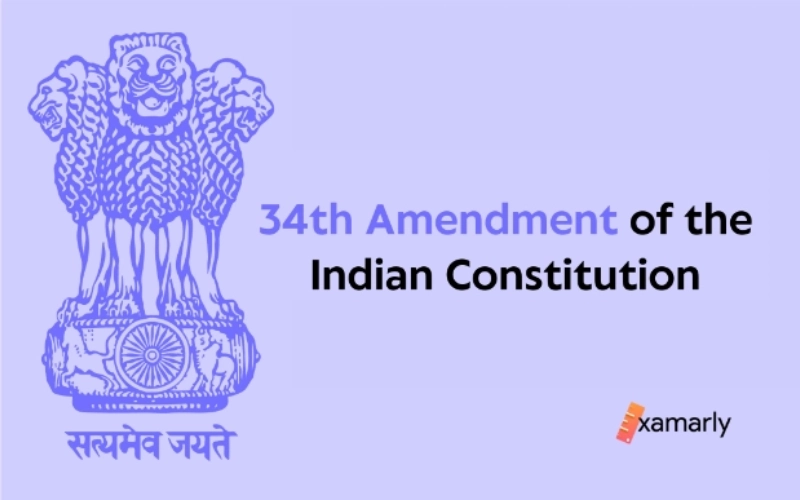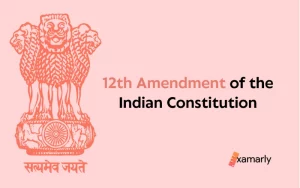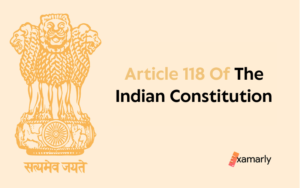The 34th Amendment of the Indian Constitution is officially termed The Constitution (Thirty-fourth Amendment) Act, 1974. The Land Reform Acts and their amendments are added to Schedule 9 of the Constitution by this amendment.
Read this article to get in-depth knowledge about the 34th amendment of the Indian constitution. This information will be very valuable to students studying for competitive exams, such as the UPSC.
34th Amendment of the Indian Constitution – A Detailed Analysis
On 7 September 1974, the 34th Amendment of the Indian Constitution came into effect. This modifies Schedule 9 of the Indian Constitution.
On July 23, 1972, at the Chief Ministers’ Conference, significant proposals were made. These proposals were about the removal of exemptions, the reduction of the maximum on land holdings, and the application of a ceiling based on the amount of land owned by a family.
It was suggested that the Constitution’s Ninth Schedule be changed in order to incorporate the updated ceiling laws. The Ninth Schedule was also expected to contain two Acts that deal with the elimination of intermediary tenures, namely-
- The Bihar Land Reforms (Amendment) Act, 1972
- The Gudalur Janmam Estates (Abolition and Conversion into Ryotwari) Act, 1969
Objects and Reasons
- On July 23, 1972, the Chief Ministers’ Conference was held. They had made significant recommendations at the conference on the removal of exemptions, reducing the bar for land ownership, and applying the limit on the basis of land held by a family. The Indian government agreed with the Chief Ministers’ Conference’s recommendations. Additionally, the State Governments received the appropriate instructions for the revision of ceiling laws.
- It is suggested to modify the Constitution’s Ninth Schedule to include the updated ceiling laws that have thus far been passed in largely broad conformity with the aforementioned guidelines. By doing this, Article 31B of the Constitution of India may shield them and eliminate any confusion or doubt that might exist regarding their legality. Two laws that deal with the elimination of intermediary tenures were the Gudalur Janmam Estates (Abolition and Conversion into Ryotwari) Act, 1969, and the Bihar Land Reforms (Amendment) Act, 1972. To ensure that they also enjoy the same protection, it was suggested that these two additional Acts be enlisted to the ninth schedule.
- The Bill aims to accomplish this goal.
Significant Provision
Amendment of the Ninth Schedule– The 34th Amendment of the Indian Constitution adds 20 more state laws (New entries 67 to 86) dealing with land reforms and ceilings to the Ninth Schedule in order to make it clear that these laws cannot be challenged on the grounds that they conflict with any sections of Part III of the Constitution’s Fundamental Rights clause.
The entries mentioned below should be added to the Constitution’s Ninth Schedule, following entry 66 and prior to the Explanation:-
| 67. | The Andhra Pradesh Land Reforms (Ceiling on Agricultural Holdings) Act, 1973 (Andhra Pradesh Act 1 of 1973). |
| 68. | The Bihar Land Reforms (Fixation of Ceiling Area and Acquisition of Surplus Land) (Amendment) Act, 1972 (Bihar Act I of 1973). |
| 69. | The Bihar Land Reforms (Fixation of Ceiling Area and Acquisition of Surplus Land) (Amendment) Act, 1973 (Bihar Act IX of 1973). |
| 70. | The Bihar Land Reforms (Amendment) Act, 1972 (Bihar Act V of 1972). |
| 71. | The Gujarat Agricultural Lands Ceiling (Amendment) Act, 1972 (Gujarat Act 2 of 1974). |
| 72. | The Haryana Ceiling on Land Holdings Act, 1972 (Haryana Act 26 of 1972). |
| 73. | The Himachal Pradesh Ceiling on Land Holdings Act, 1972 (Himachal Pradesh Act 19 of 1973). |
| 74. | The Kerala Land Reforms (Amendment) Act, 1972 (Kerala Act 17 of 1972). |
| 75. | The Madhya Pradesh Ceiling on Agricultural Holdings (Amendment) Act, 1972 (Madhya Pradesh Act 12 of 1974). |
| 76. | The Madhya Pradesh Ceiling on Agricultural Holdings (Second Amendment) Act, 1972 (Madhya Pradesh Act 13 of 1974). |
| 77. | The Mysore Land Reforms (Amendment) Act, 1973 (Karnataka Act 1 of 1974). |
| 78. | The Punjab Land Reforms Act, 1972 (Punjab Act 10 of 1973). |
| 79. | The[[B Rajasthan Imposition of Ceiling on Agricultural Holdings Act, 1973 (Rajasthan Act 11 of 1973). |
| 80. | The Gudalur Janmam Estates (Abolition and Conversion into Ryotwari) Act, 1969 (Tamil Nadu Act 24 of 1969). |
| 81. | The West Bengal Land Reforms (Amendment) Act, 1972 (West Bengal Act XII of 1972). |
| 82. | The West Bengal Estates Acquisition (Amendment) Act, 1964 (West Bengal Act XXII of 1964). |
| 83. | The West Bengal Estates Acquisition (Second Amendment) Act, 1973 (West Bengal Act XXXIII of 1973). |
| 84. | The Bombay Tenancy and Agricultural Lands (Gujarat Amendment) Act, 1972 (Gujarat Act 5 of 1973). |
| 85. | The Orissa Land Reforms (Amendment) Act, 1974 (Orissa Act 9 of 1974). |
| 86. | The Tripura Land Revenue and Land Reforms (Second Amendment) Act, 1974 (Tripura Act 7 of 1974). |
Conclusion
The 34th Amendment remains an important chapter in the story of Indian democracy, which went into effect on 7 September 1974, i.e., the 25th year of the Indian Republic.
In conclusion, the 34th Amendment of the Indian Constitution remains an important milestone in the evolution of Indian democracy. The amendment brought about significant changes to the constitutional framework of the country, particularly with respect to the powers of the Parliament to amend the Constitution and the rights of the citizens.






